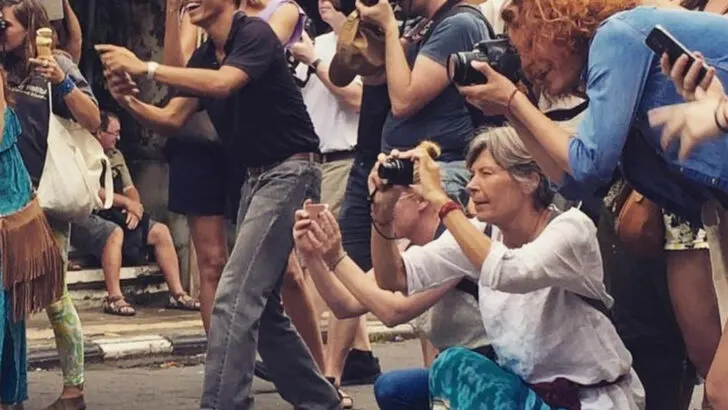You’re loud, you’re lost, and you’re waving that map like it’s a trophy. Yep, you’re that American tourist in Europe. It’s a wild adventure filled with awkward moments, giant backpacks, and asking for “the best espresso” in every accent imaginable. From overpacked days to unintentionally hilarious cultural blunders, you’re a walking, talking cliché—and you’re owning it. But hey, these 14 obvious signs? They’re proof you’re diving headfirst into the chaos and charm of European travel. So buckle up, embrace the quirks, and get ready to laugh at yourself—because being an American tourist abroad is part of the fun!
You’re Carrying a Giant Backpack and Rolling Suitcase
A grand adventure requires grand preparation, or so many American tourists believe. Arriving in Europe, they often carry an imposing backpack and a rolling suitcase, ready for anything. This practical yet overpacked approach contrasts sharply with the locals’ minimalist and chic travel style. While Europeans may opt for a sleek tote or a compact carry-on, Americans are ready for any scenario. It’s not just about the luggage itself, but the sense of being prepared for anything and everything. A true sight among locals traveling light, the American tourist stands ready for all contingencies.
You’re Wearing Sneakers Everywhere, Even at Dinner
Sneakers symbolize comfort and practicality, the cornerstone of American travel fashion. Whether exploring historical sites or dining at a Michelin-starred restaurant, sneakers are the footwear of choice. This casual approach to footwear can stand out in cities where dressier shoes are the norm for evenings out. For Americans, the trade-off between style and comfort often leans heavily towards comfort, making sneakers a constant companion. It’s a nod to the bustling, on-the-go lifestyle typical of many American travelers. In Europe, this footwear choice might turn heads, but for the American tourist, it simply feels right.
You’re Confidently Using Your Phone’s GPS, Even When Lost
Lost, but never truly, thanks to technology. The smartphone GPS becomes an American tourist’s best friend, guiding them through winding European streets with confidence. While locals might rely on intuition, paper maps, or even local advice, Americans embrace the digital age entirely. The constant phone-checking habit is a modern-day navigation tool, essential for exploring foreign lands. This digital dependency can be charmingly naive, yet it’s a sign of the times, illustrating the American tourist’s blend of tech-savvy exploration and a quest for adventure. For them, the world is at their fingertips, literally.
You’re Speaking Loudly in English, Often Without Trying to Lower Your Voice
The art of conversation takes on a different tone when American tourists are involved. Known for their expressive and open communication style, they might unintentionally speak louder than the softly conversing locals. A casual chat in English can turn into a spectacle in the hushed environments of European cafes. This vibrant way of communicating reflects an openness and friendliness, though it sometimes startles the more reserved European patrons. Yet, it’s this very characteristic that makes American tourists so engaging, as they bring a piece of their homeland’s warmth and exuberance wherever they go.
You’re Taking Photos of Everything—Even Street Signs and Storefronts
Capturing every moment, American tourists transform everyday scenes into cherished memories. From ornate monuments to charming street signs, everything is worthy of a snapshot. Their enthusiasm for documentation showcases a deep appreciation for their surroundings, even if locals find it amusingly excessive. This photographic fervor is a blend of curiosity and wishful preservation, allowing American tourists to relive their travels long after returning home. It’s not just about the photos themselves but the stories and memories they encapsulate. For American tourists, every click of the camera is a way to hold onto the adventure.
You’re Wearing Baseball Caps or Clothing with American Sports Logos
Sporting a piece of home, American tourists proudly wear baseball caps and sports jerseys, even miles away from their favorite teams. This fashion choice is a nod to their roots, a subtle yet distinct signal of their identity. In Europe, where local soccer team merchandise dominates, these American sports logos stand out like cultural flags. It’s about more than just team loyalty; it’s a connection to home and a conversation starter among curious onlookers. This visible allegiance is both a comfort and a curiosity, marking American tourists with an unmistakable flair for sporting pride.
You’re Ordering ‘American-Style’ Food at Restaurants
When in Rome, order a burger? For some American tourists, the call of comfort food is irresistible, leading them to seek out familiar dishes even in Europe’s culinary heartlands. Whether it’s a towering burger or a hefty side of fries, these choices stand out in a landscape of refined, local flavors. This quest for the familiar amidst foreign fare can prompt smiles from locals, who may find the preference for well-known cuisine endearing. It’s a small act of cultural preservation, a taste of home in a world of new experiences, where the familiar sometimes tastes best.
You’re Using US Dollars or Asking About Currency Exchange Often
Currency confusion is a hallmark of the American tourist experience. Accustomed to the greenback, they often find themselves navigating the complexities of euros, pounds, and other currencies. This financial adjustment can lead to frequent inquiries at exchange counters or questions about conversion rates. While locals seamlessly handle their currency, American tourists may appear endearingly perplexed. This monetary bewilderment is part of the travel adventure, a learning curve that adds a touch of authenticity to their journey. It’s a small reminder that even in a globalized world, some things still require a little getting used to.
You’re Wearing Bright, Casual Clothing in Cities Known for Chic Fashion
Bright colors and casual attire define the American tourist’s wardrobe, a vibrant contrast in Europe’s fashion capitals. While locals exude sophistication with muted tones and tailored fits, American tourists bring a splash of color and comfort. This sartorial choice is a reflection of their laid-back spirit and individuality. Amidst the sea of chic elegance, the casual, bold attire of American tourists is both noticeable and refreshing. It’s a style that speaks volumes about their adventurous, free-spirited nature, unafraid to stand out in a crowd. This clothing choice is a celebration of comfort and personal expression.
You’re Eager to Visit Every Tourist Landmark in One Day
With an itinerary packed to the brim, American tourists often aim to see it all, cramming famous landmarks into a single day. This whirlwind approach contrasts with the leisurely pace favored by locals, who savor each experience. Armed with maps and cameras, they race from site to site, determined to capture every iconic view. This energetic exploration reflects their curious nature and desire to maximize every moment of their trip. It’s a testament to their enthusiasm, a lively dance through history and culture. For American tourists, a day well-spent is one filled with memories and discovery.
You’re Surprised by Small Portions or Different Meal Times
Dining in Europe reveals a stark culinary contrast for American tourists. Accustomed to generous servings and early dinner times, they might find themselves surprised by smaller portions and later meal schedules. This cultural adjustment highlights differences in dining traditions, offering a fresh perspective on food and mealtime rituals. While locals enjoy leisurely meals that prioritize quality over quantity, American tourists may initially find the experience puzzling. Yet, it’s an opportunity for them to embrace new tastes and rhythms. This surprise at the table enriches their travel experience, adding flavor and insight to their journey.
You’re Using English-Only Apps and Guides
Technology becomes a steadfast companion for American tourists, as they rely on English-only apps and guides to navigate Europe. While these tools offer convenience and familiarity, they can also limit interactions with locals. This reliance on digital assistance reflects a preference for comfort and ease, even amidst the intrigue of foreign languages. For American tourists, these apps are both a map and a guide, providing confidence in unfamiliar territories. Despite this digital barrier, their curiosity remains undeterred, as they explore with enthusiasm and a spirit of adventure, finding connections beyond language through shared experiences.
You’re Tip Calculating with US Standards, Not European Customs
Tipping can be a perplexing endeavor for American tourists, accustomed to the 15-20% standard back home. In Europe, where tipping customs vary widely, this familiar practice may lead to over-tipping or confusion. This difference in etiquette highlights the nuances of cross-cultural dining experiences. While locals might offer a modest gratuity, American tourists often grapple with this new norm. It’s a financial faux pas that can amuse or perplex, yet it speaks to their generous nature. For Americans, tipping reflects both appreciation and habit, a small gesture that bridges cultures, even if the calculation requires a bit of adjustment.
You’re Wearing a Fanny Pack or Carrying a Money Belt
Security and convenience meet fashion in the form of fanny packs and money belts, favored by American tourists. These practical accessories keep valuables close, offering peace of mind in bustling European markets. While locals might opt for more fashionable bags, these items signal a visitor’s cautious approach. It’s a blend of functionality and travel savvy, ensuring essentials are always within reach. For American tourists, fanny packs are more than mere bags; they’re travel companions, safeguarding passports and currency. This accessory choice highlights their pragmatic side, a nod to adventure with a sprinkle of security-consciousness.

